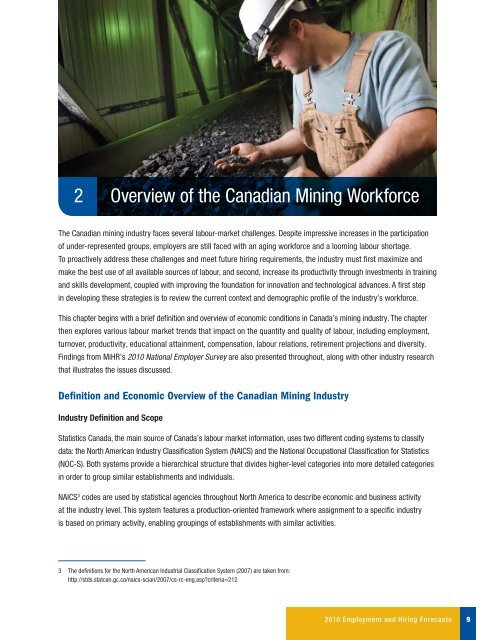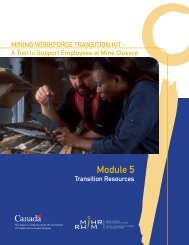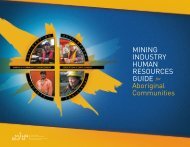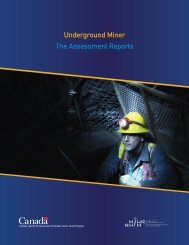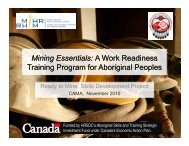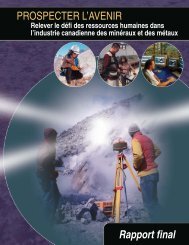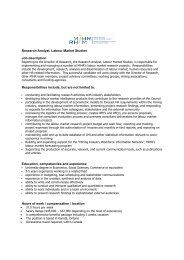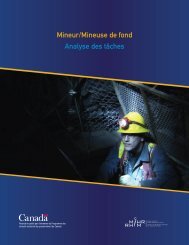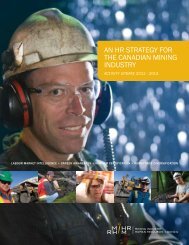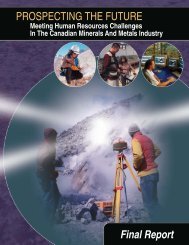Canadian Mining Industry Employment and Hiring Forecasts - MiHR
Canadian Mining Industry Employment and Hiring Forecasts - MiHR
Canadian Mining Industry Employment and Hiring Forecasts - MiHR
Create successful ePaper yourself
Turn your PDF publications into a flip-book with our unique Google optimized e-Paper software.
2 Overview of the <strong>Canadian</strong> <strong>Mining</strong> Workforce<br />
The <strong>Canadian</strong> mining industry faces several labour-market challenges. Despite impressive increases in the participation<br />
of under-represented groups, employers are still faced with an aging workforce <strong>and</strong> a looming labour shortage.<br />
To proactively address these challenges <strong>and</strong> meet future hiring requirements, the industry must first maximize <strong>and</strong><br />
make the best use of all available sources of labour, <strong>and</strong> second, increase its productivity through investments in training<br />
<strong>and</strong> skills development, coupled with improving the foundation for innovation <strong>and</strong> technological advances. A first step<br />
in developing these strategies is to review the current context <strong>and</strong> demographic profile of the industry’s workforce.<br />
This chapter begins with a brief definition <strong>and</strong> overview of economic conditions in Canada’s mining industry. The chapter<br />
then explores various labour market trends that impact on the quantity <strong>and</strong> quality of labour, including employment,<br />
turnover, productivity, educational attainment, compensation, labour relations, retirement projections <strong>and</strong> diversity.<br />
Findings from <strong>MiHR</strong>’s 2010 National Employer Survey are also presented throughout, along with other industry research<br />
that illustrates the issues discussed.<br />
Definition <strong>and</strong> Economic Overview of the <strong>Canadian</strong> <strong>Mining</strong> <strong>Industry</strong><br />
<strong>Industry</strong> Definition <strong>and</strong> Scope<br />
Statistics Canada, the main source of Canada’s labour market information, uses two different coding systems to classify<br />
data: the North American <strong>Industry</strong> Classification System (NAICS) <strong>and</strong> the National Occupational Classification for Statistics<br />
(NOC-S). Both systems provide a hierarchical structure that divides higher-level categories into more detailed categories<br />
in order to group similar establishments <strong>and</strong> individuals.<br />
NAICS 3 codes are used by statistical agencies throughout North America to describe economic <strong>and</strong> business activity<br />
at the industry level. This system features a production-oriented framework where assignment to a specific industry<br />
is based on primary activity, enabling groupings of establishments with similar activities.<br />
3 The definitions for the North American Industrial Classification System (2007) are taken from:<br />
http://stds.statcan.gc.ca/naics-scian/2007/cs-rc-eng.asp?criteria=212<br />
2010 <strong>Employment</strong> <strong>and</strong> <strong>Hiring</strong> <strong>Forecasts</strong><br />
9


